Briefly: In our opinion, full (150% of the regular full position) speculative short positions in gold, silver and mining stocks are justified from the risk/reward perspective at the moment of publishing this alert.
The USD Index rallied on Friday and the precious metals market declined, but neither of them broke decisively above/below their respective resistance/support levels. The USD closed very close to the 95 level, while gold and mining stocks closed at their previous lows. What are the implications? Will gold rally from here?
Let’s jump right into the charts (chart courtesy of http://stockcharts.com).
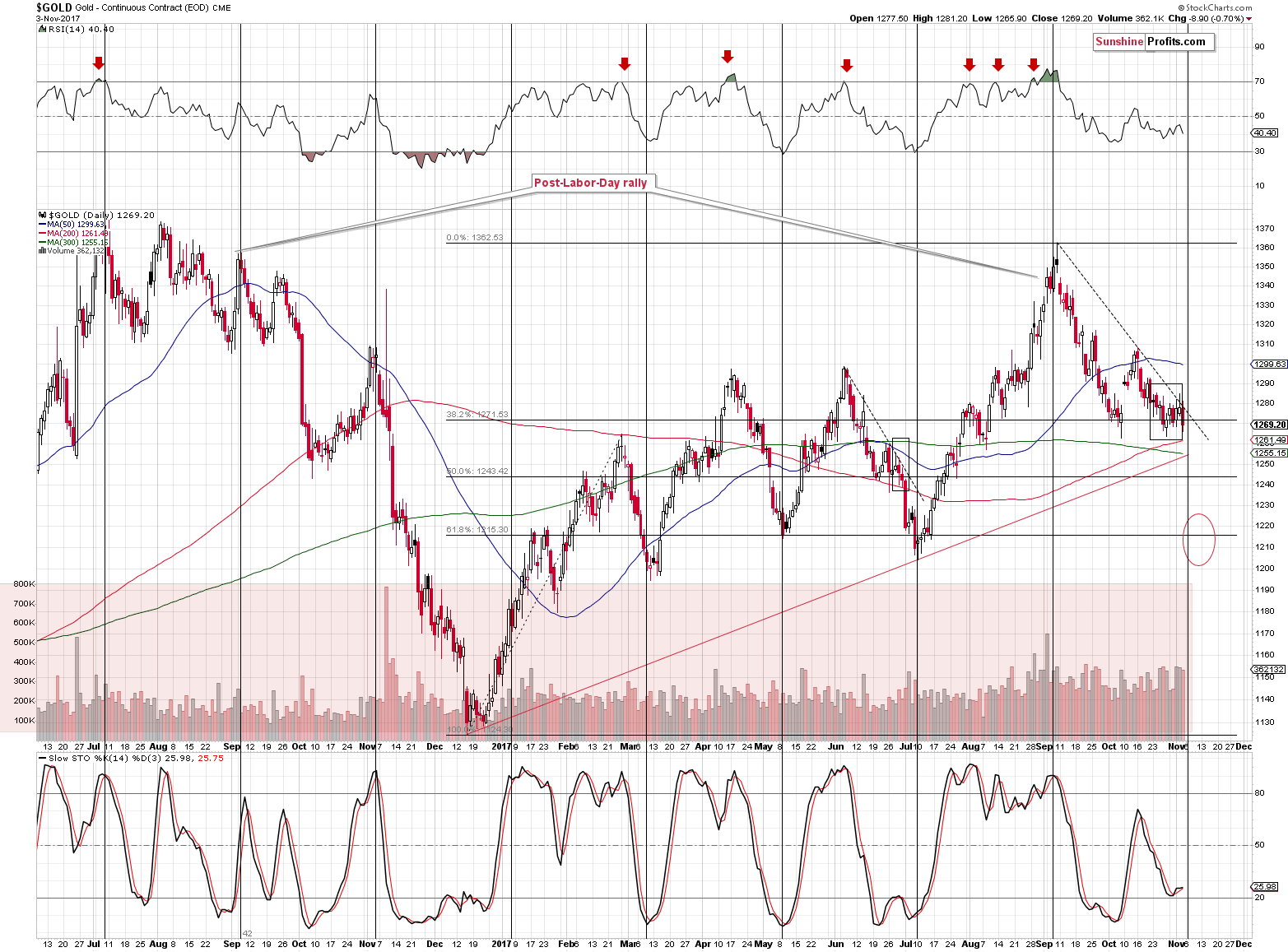
In our previous alert, we wrote the following:
We also see that the cyclical turning point in gold is just around the corner, so we could see a sharp move (most likely to the downside) any minute now. However, let’s keep in mind that the above is not certain and the turning point could market a local top instead of a major bottom.
If we see another upswing today (even if it is just a few-dollar one), then latest very short-term move will be to the upside and the turning point will have bearish implications. What would it change for us? It would simply mean that the $1,200 - $1,220 target area would not be reached within a few days, but within 1-3 weeks. In other words, all of the long-term signals would still be very likely to come into play, but they would do so with a 1-3-week delay. In this case, we could see a repeat of last year’s November and gold’s pause around $1,200 could be very brief.
Still, based on the recent performance in silver, gold’s invalidation and verification of a breakout and a breakdown in USD and gold stocks, respectively, it seems that the decline is likely to start shortly.
Today, we would like to add that the June-July decline that appears similar to the current one was also characterized by a pause at the previous lows just before the sharpest part of the decline. The outlook remains bearish, but we are monitoring the market for signs that a bigger corrective upswing could be seen before a slide to $1,200-$1,220. This doesn’t appear likely, but still, could happen based on the current turning point.
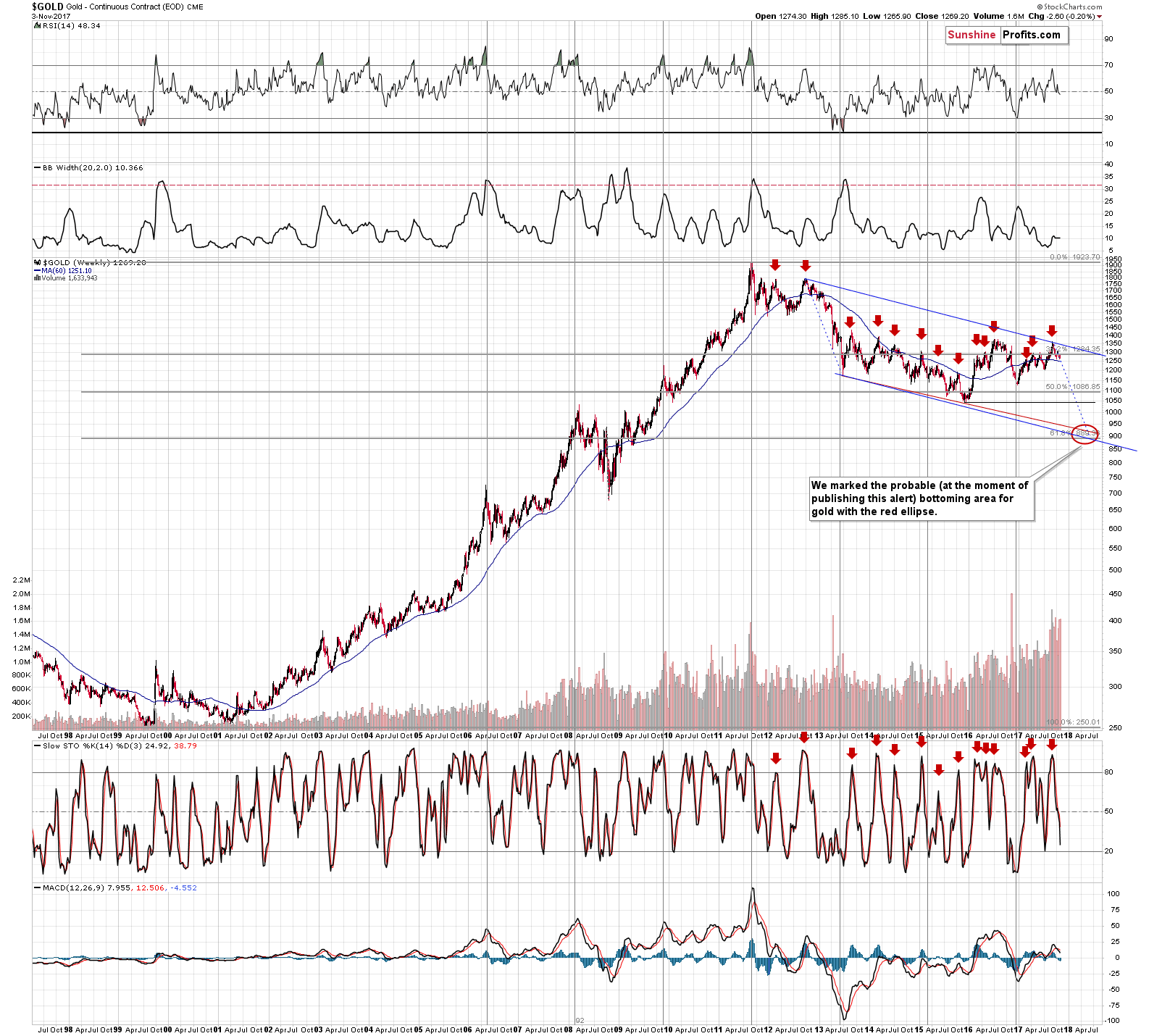
From the long-term point of view, we see that the decline is progressing at a rate that’s faster than what we saw in 2012. This could imply that we’ll see a corrective upswing shortly, as gold is approaching its 50-week moving average (that’s what triggered a corrective upswing in 2012) – it’s at about $1,250.
However, based on other charts and analogies (for instance the gold-NIKKEI link) the current situation is like the early 2013 action, not the late-2012 one and we could be right before a sizable slide which would then be followed by a corrective upswing.
Both scenarios appear possible based on the positions of indicators visible on the above chart.
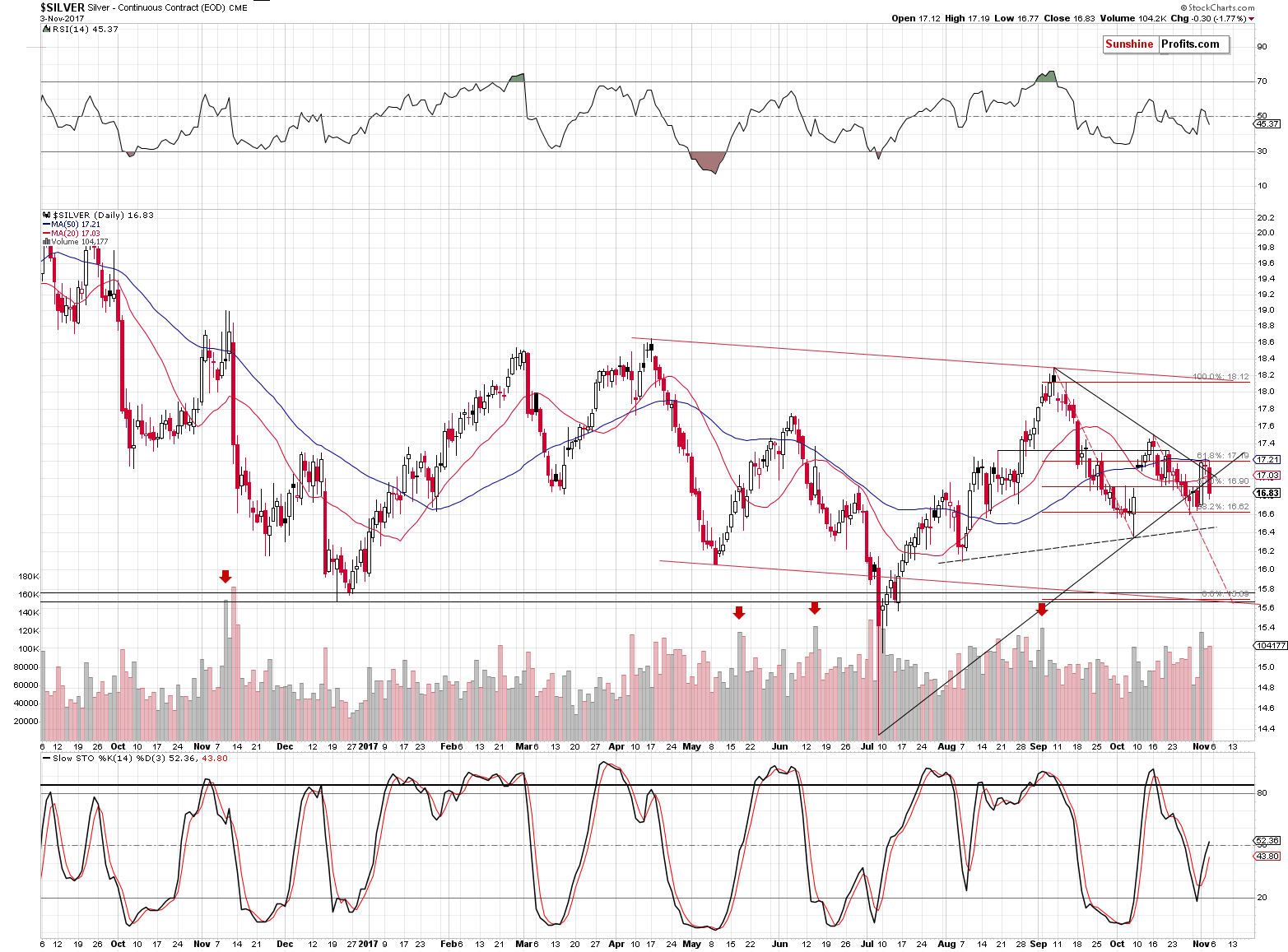
Silver’s recent outperformance suggests that a slide is just around the corner, however, both mentioned scenarios mean a decline (to $1,250 or $1,200-$1,220), so the above doesn’t help in determining which of them is more likely.
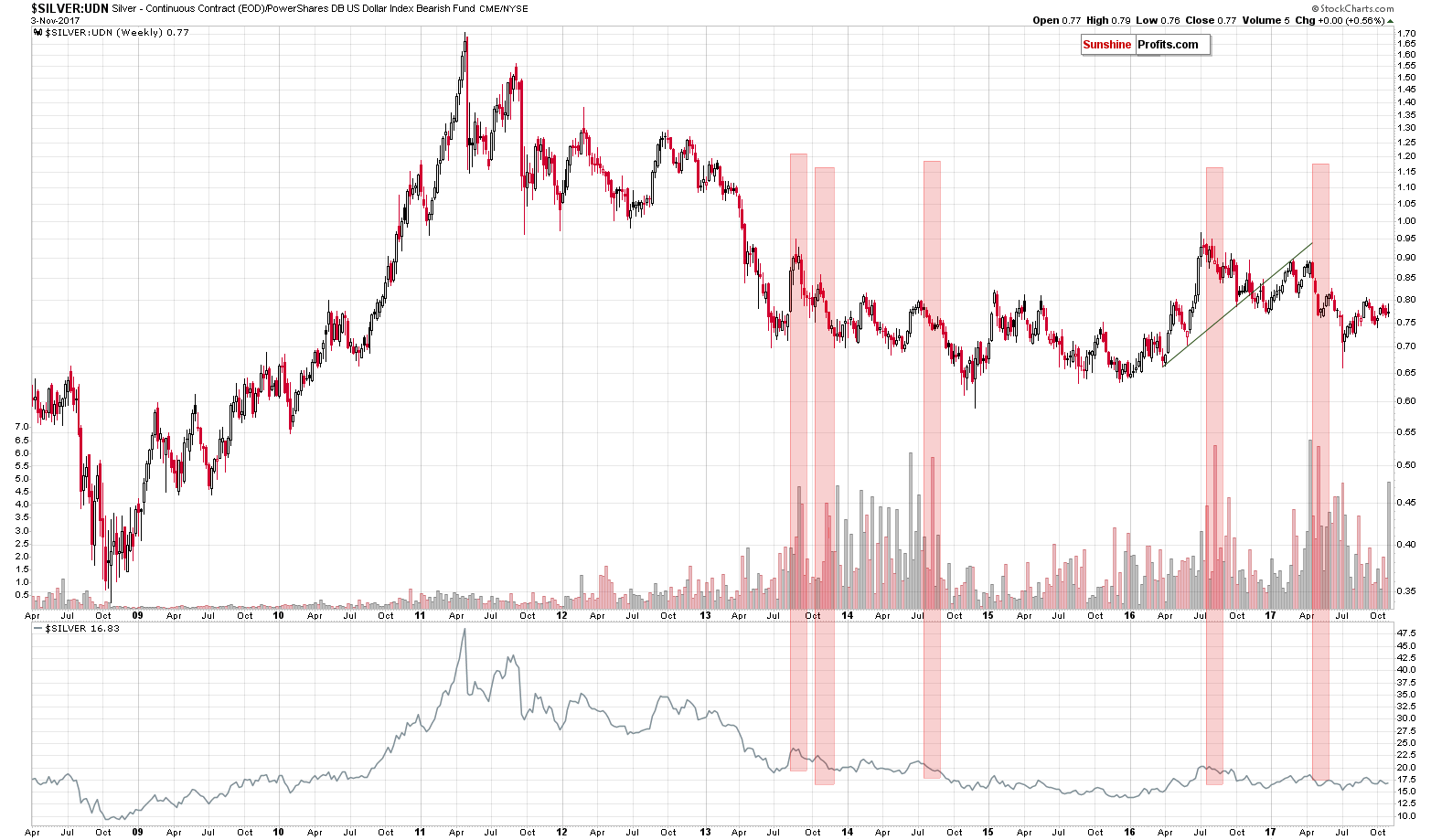
Silver’s non-USD performance is also something that should be kept in mind (the average of prices of silver in terms of currencies other than the U.S. dollar) and the same goes for the ratio of weekly volumes between silver and the UDN ETF. Spikes in this ratio indicate extraordinary interest in the price of the white metal and there were many cases in the past when this served as an indication of much lower prices in the following weeks and months. This signal doesn’t say anything about the short term, but the medium-term implications are bearish.

The same kind of implications are provided by the Dow to gold ratio. It moved higher and more than confirmed its breakout above the previous highs. The last time when we saw a major breakout in this ratio was in early 2013 and it meant that gold’s price was about to slide for hundreds of dollars.
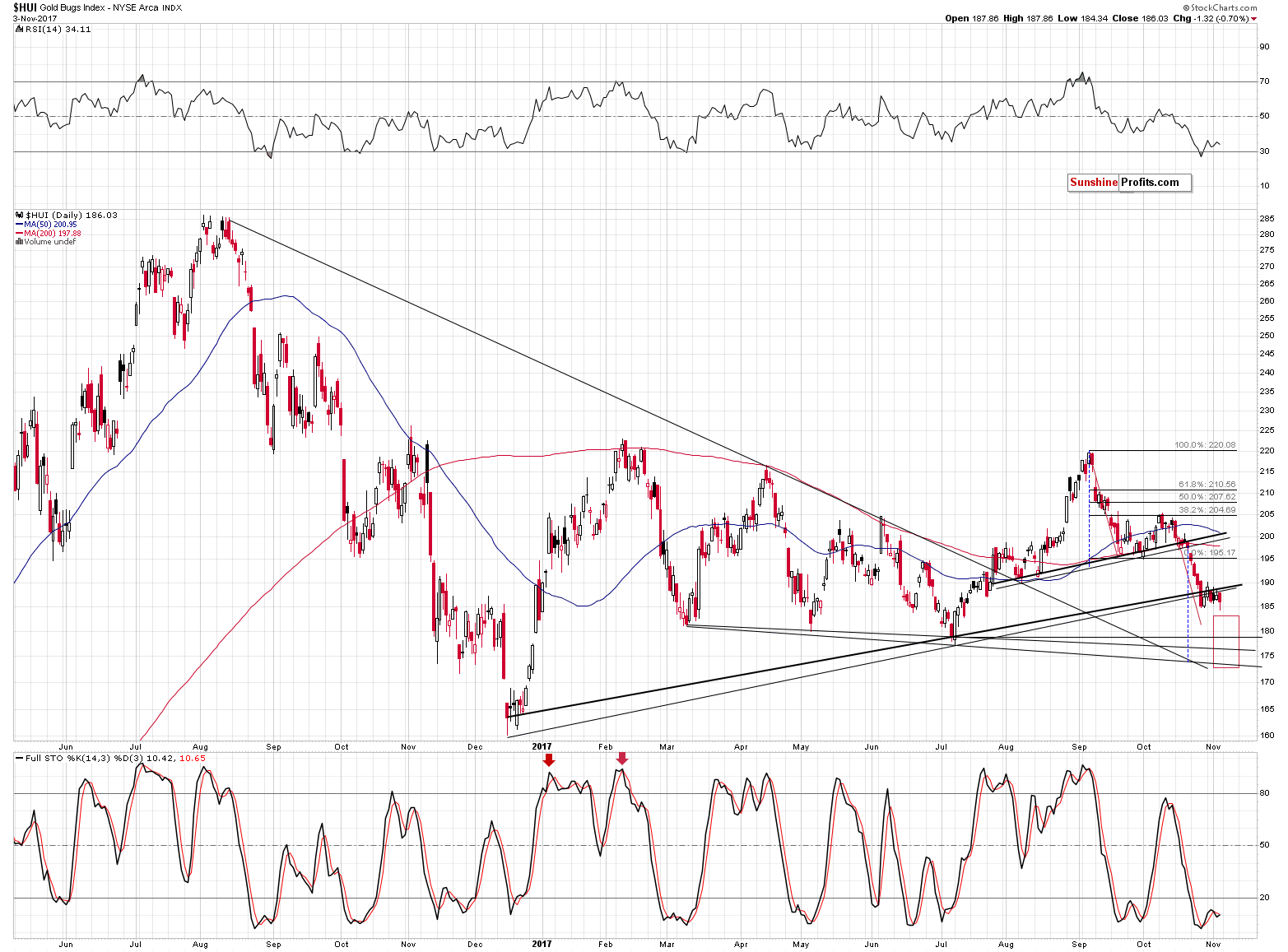
Even though they erased a sizable part of their Friday decline, gold stocks still ended the week lower and verified their breakdown below the rising support lines. The target around the 175 level in the HUI Index remains up-to-date. This level could correspond to both mentioned targets in gold.
After a decline, a corrective upswing seems quite likely as it would be in tune with the previous huge decline.
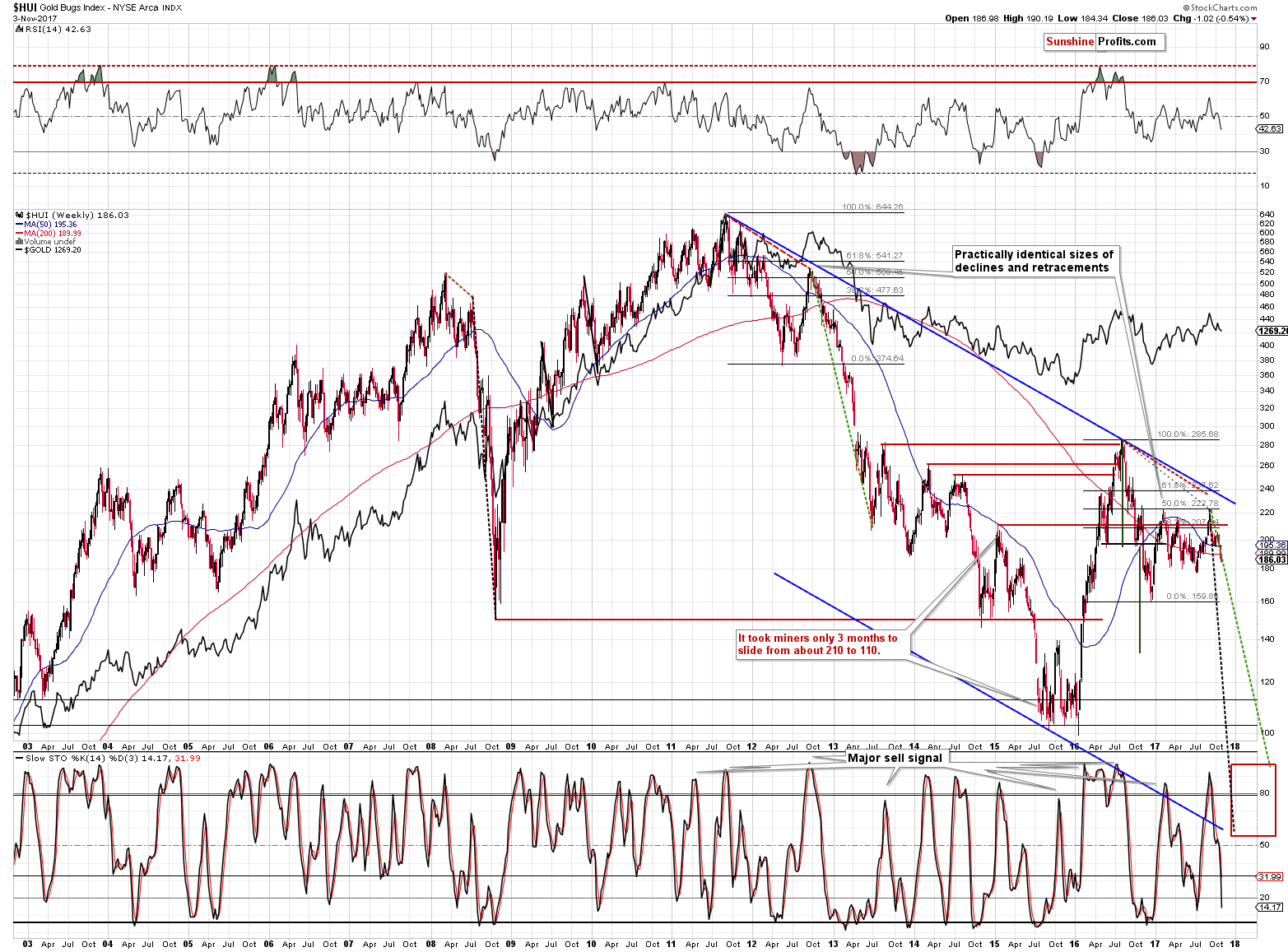
Since the September top, gold miners have been declining almost identically as they did in late 2012 – please note how the HUI Index follows the green dashed line. The important thing is that before the decline accelerated in 2013, we saw a brief but visible (even from the long-term perspective) corrective upswing. Since the declines have been similar so far, we can expect something similar relatively soon.
Another interesting thing is that back in 2013, the previous major bottom (the 2012 bottom) didn’t stop the decline at all – there was only a small post-breakdown correction. If the current decline remains in tune with the 2012-2013 one, then we shouldn’t expect to see a bigger pause at the late 2016 bottom.
The USD Index also points to a reversal after an additional move in the most recent direction.
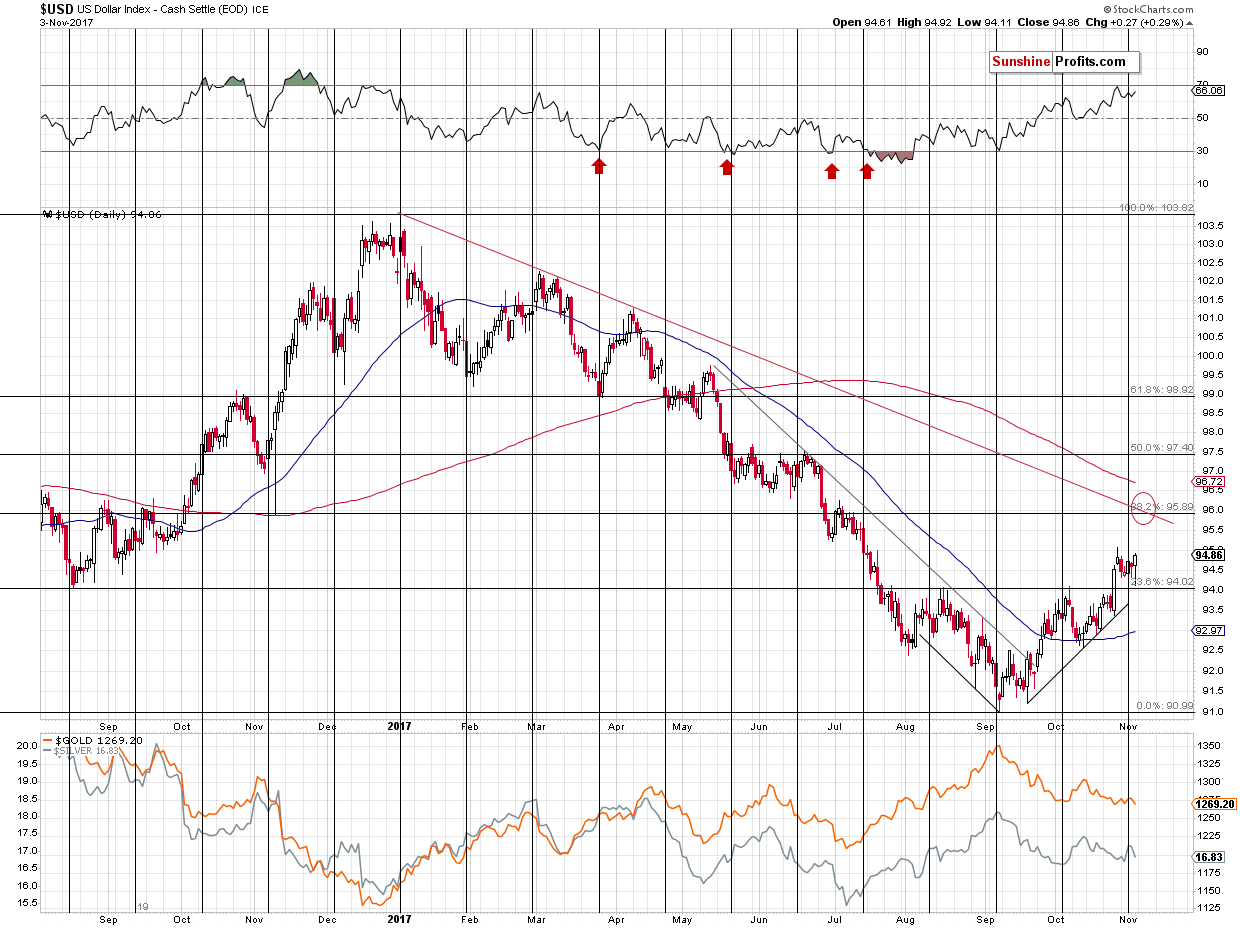
The breakout above the neck level of the reverse head and shoulders pattern is more than confirmed, so another rally appears very likely to be seen this week. The target at about 96 level (precisely 95.89) is supported by the declining red resistance line and the 38.2% Fibonacci resistance level. Both are based on a clearly visible, medium-term move, so they are important.
Now, let’s consider the follow-up action.
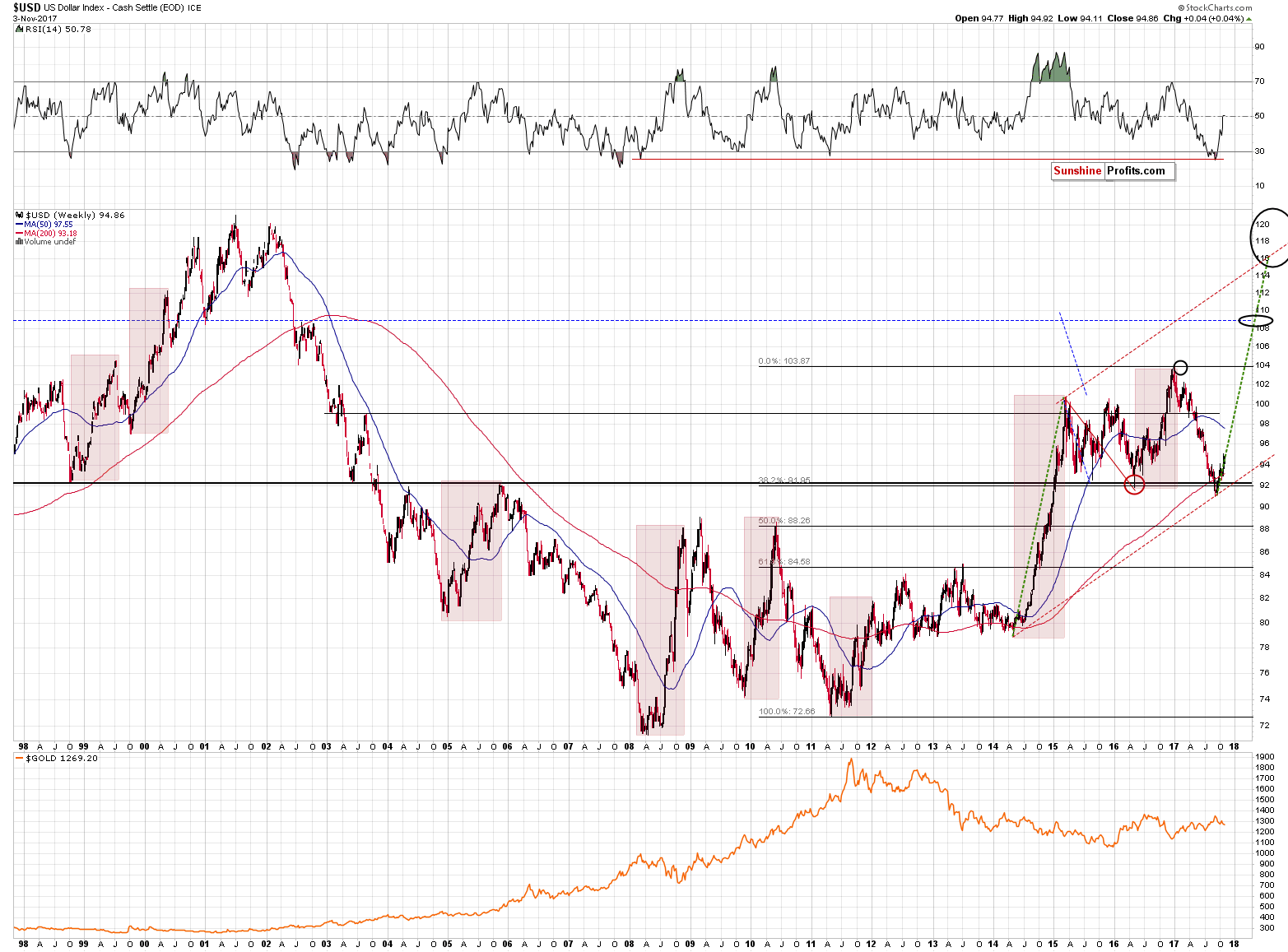
If the USD Index is starting a huge rally, just like it’s likely to based on where we are in the series of interest rate hikes, then it’s a good idea to check how the previous big USD rallies looked like and look for similarities. In this way we could spot trading opportunities (and look for confirmations at particularly important moments / price levels) and even if we don’t, the above should still prepare one for what’s to come and one would not panic in light of an event that would appear a game-changer on a day-to-day basis, but would be normal when looked at from the long-term perspective.
We marked 8 big rallies on the above 20-year chart. They vary in terms of length, size and sharpness, but there are a few similarities between them. The rallies took between (approximately) 30 and 45 weeks, so the current possible rally could end between April and July 2018, but that’s not something that has implications for the nearby days and weeks. However, analyzing the beginnings of the big rallies has such implications.
The first part of 6 out of 8 big rallies was characterized by a rather large pullback. In 1998, 2005, 2008, 2011, 2014 and 2016 the biggest, most stable and bullish part of the rally took place only after an initial correction that erased more than half of the very initial rally.
In the remaining two cases, the correction was still present, but it was not that significant.
So, should we expect the current rally to continue much higher without a bigger correction? No, such a correction would be something rather likely and normal. If the 50% correction is to be the minimum range for the pullback and the USD tops at about 96, then we can expect it to decline to about 93 – 93.5.
That would not be a small move, so adjusting one’s trading positions might be a good idea should it become very likely. The same is the case for the positions in the precious metals market as a bigger correction in the USD would likely translate into a visible correction in metals and miners.
Summing up, it seems likely that after an additional decline the precious metals sector would be likely to correct before continuing the decline. This action would not be a bullish development from the medium-term point of view as it would be something natural at this stage of the decline and the opposite can be said about the upcoming pullback in the value of the USD Index. To be clear, the medium-term outlook remains bearish, especially that the analogy to the 2012-2013 decline remains in place and the previously discussed long-term signals remain in place: gold’s huge monthly volume, the analogy in the HUI Index, the analogy between the two most recent series of interest rate hikes, and the RSI signal from gold priced in the Japanese yen. However, it seems to be a good idea to take advantage of the upcoming short-term correction, should we get bullish confirmations from metals or miners.
As always, we will keep you – our subscribers – informed.
To summarize:
Trading capital (supplementary part of the portfolio; our opinion): Short positions (150% of the full position) in gold, silver and mining stocks are justified from the risk/reward perspective with the following stop-loss orders and exit price levels / profit-take orders:
- Gold: exit price: $1,218; stop-loss: $1,366; exit price for the DGLD ETN: $51.98; stop-loss for the DGLD ETN $38.74
- Silver: exit price: $15.82; stop-loss: $19.22; exit price for the DSLV ETN: $28.88; stop-loss for the DSLV ETN $17.93
- Mining stocks (price levels for the GDX ETF): exit price: $21.23; stop-loss: $26.34; exit price for the DUST ETF: $29.97; stop-loss for the DUST ETF $21.37
In case one wants to bet on junior mining stocks' prices (we do not suggest doing so – we think senior mining stocks are more predictable in the case of short-term trades – if one wants to do it anyway, we provide the details), here are the stop-loss details and exit prices:
- GDXJ ETF: exit price: $30.28; stop-loss: $45.31
- JDST ETF: exit price: $66.27; stop-loss: $43.12
Long-term capital (core part of the portfolio; our opinion): No positions (in other words: cash)
Insurance capital (core part of the portfolio; our opinion): Full position
Important Details for New Subscribers
Whether you already subscribed or not, we encourage you to find out how to make the most of our alerts and read our replies to the most common alert-and-gold-trading-related-questions.
Please note that the in the trading section we describe the situation for the day that the alert is posted. In other words, it we are writing about a speculative position, it means that it is up-to-date on the day it was posted. We are also featuring the initial target prices, so that you can decide whether keeping a position on a given day is something that is in tune with your approach (some moves are too small for medium-term traders and some might appear too big for day-traders).
Plus, you might want to read why our stop-loss orders are usually relatively far from the current price.
Please note that a full position doesn’t mean using all of the capital for a given trade. You will find details on our thoughts on gold portfolio structuring in the Key Insights section on our website.
As a reminder – “initial target price” means exactly that – an “initial” one, it’s not a price level at which we suggest closing positions. If this becomes the case (like it did in the previous trade) we will refer to these levels as levels of exit orders (exactly as we’ve done previously). Stop-loss levels, however, are naturally not “initial”, but something that, in our opinion, might be entered as an order.
Since it is impossible to synchronize target prices and stop-loss levels for all the ETFs and ETNs with the main markets that we provide these levels for (gold, silver and mining stocks – the GDX ETF), the stop-loss levels and target prices for other ETNs and ETF (among other: UGLD, DGLD, USLV, DSLV, NUGT, DUST, JNUG, JDST) are provided as supplementary, and not as “final”. This means that if a stop-loss or a target level is reached for any of the “additional instruments” (DGLD for instance), but not for the “main instrument” (gold in this case), we will view positions in both gold and DGLD as still open and the stop-loss for DGLD would have to be moved lower. On the other hand, if gold moves to a stop-loss level but DGLD doesn’t, then we will view both positions (in gold and DGLD) as closed. In other words, since it’s not possible to be 100% certain that each related instrument moves to a given level when the underlying instrument does, we can’t provide levels that would be binding. The levels that we do provide are our best estimate of the levels that will correspond to the levels in the underlying assets, but it will be the underlying assets that one will need to focus on regarding the signs pointing to closing a given position or keeping it open. We might adjust the levels in the “additional instruments” without adjusting the levels in the “main instruments”, which will simply mean that we have improved our estimation of these levels, not that we changed our outlook on the markets. We are already working on a tool that would update these levels on a daily basis for the most popular ETFs, ETNs and individual mining stocks.
Our preferred ways to invest in and to trade gold along with the reasoning can be found in the how to buy gold section. Additionally, our preferred ETFs and ETNs can be found in our Gold & Silver ETF Ranking.
As a reminder, Gold & Silver Trading Alerts are posted before or on each trading day (we usually post them before the opening bell, but we don't promise doing that each day). If there's anything urgent, we will send you an additional small alert before posting the main one.
=====
Latest Free Trading Alerts:
The U.S. economy added 261,000 jobs in October. What does it mean for the gold market?
Payrolls in October 2018 and Gold
S&P 500 index gained 0.3% on Friday, following monthly jobs data release, among others. Will uptrend continue towards 2,600 mark? Or is this a topping pattern ahead of some downward reversal?
Topping Pattern Or Just Pause Before Another Leg Up?
=====
Hand-picked precious-metals-related links:
PRECIOUS-Gold edges back above $1,270/oz as dollar steadies, yields slip
Asia gold-wedding bells set to ring in fresh demand in India
=====
In other news:
Departure of New York Fed's Dudley hangs another question over Fed leadership
Missing pay rises: the ever deepening economics mystery
=====
Thank you.
Sincerely,
Przemyslaw Radomski, CFA
Founder, Editor-in-chief, Gold & Silver Fund Manager
Gold & Silver Trading Alerts
Forex Trading Alerts
Oil Investment Updates
Oil Trading Alerts



